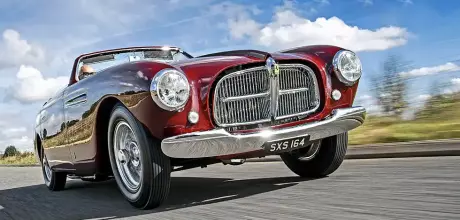1951 Ferrari 212 Inter Cabriolet by Vignale
This Vignale-bodied 212 Inter was owned by one of the first privateers to campaign Ferraris in motor sport. It’s in the UK after a 50-year absence – a chance for us to drive back to the early days of the marque.
Words SAM DAWSON
Photography STUART COLLINS
The Art of Performance Driving a race team boss’s Vignale Ferrari 212 Inter Cabriolet
An artistically-minded racer’s Ferrari 212 on the road
Race team bosses always own the most interesting cars in the paddock. Racing drivers themselves, typically young, sometimes cash-strapped employees, usually drive whatever the team gives them. Engineers might have a scruffy, eccentric self-built special. The sponsor’s CEO will probably be driven to the circuit in an anonymous stretched limousine.
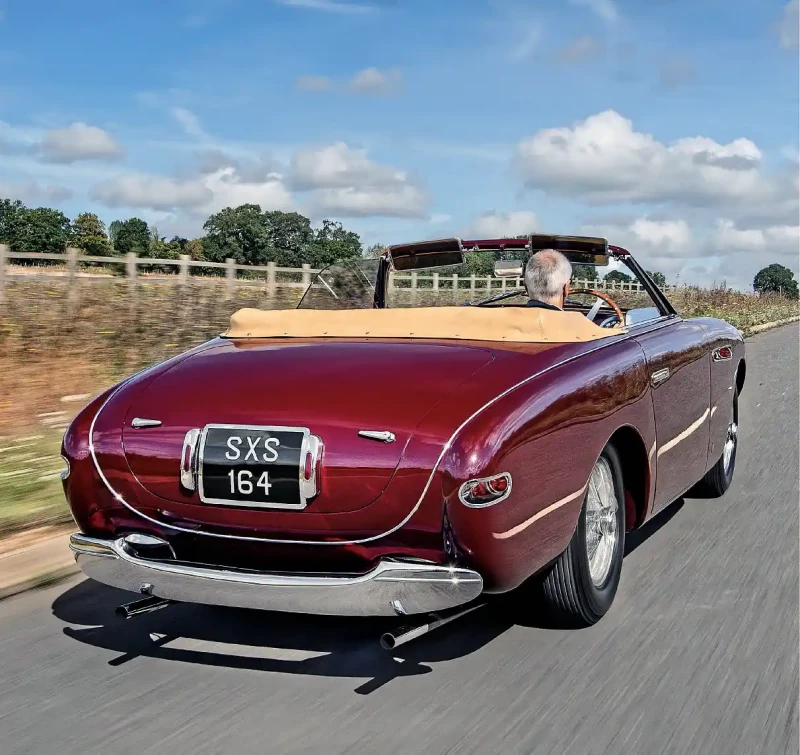
But the team boss has that combination of wealth, experience, an inclination to indulge themselves, plus an undying passion for racing that can result in the most spectacular of daily drivers. Consider Walter Wolf’s Dallaramodified Lamborghini Countach, which formed the basis of the LP400S, or Colin Chapman’s fully-liveried Lotus Elites. Carroll Shelby always drove one of his own 427 Cobras. Gulf Racing mastermind John Wyer had a roadgoing Ford GT40.
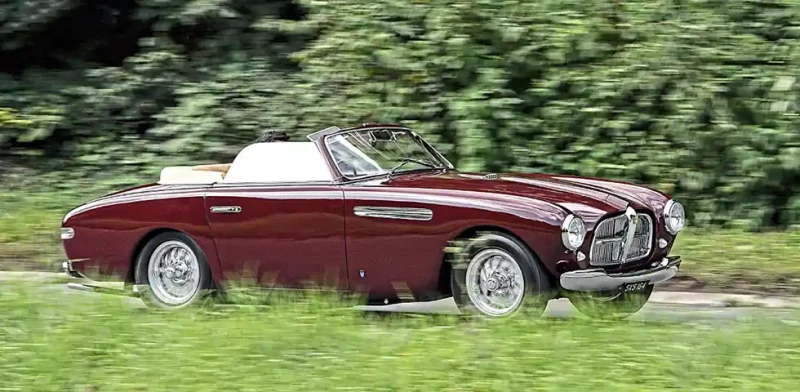
‘Think of it as the upstart heir to cars like the Bugatti Atlantic and Talbot-Lago T150 CSS’
From what I can tell, ensconced behind the wheel of this Vignale-bodied Ferrari 212 Inter, Peter Staechelin was a man cut from the same cloth. This was his Ferrari, and it may have the veneer of luxury, the appearance of elegance, but all it takes is a grip of its steering wheel, press of a pedal or shift of the gear lever to feel the resistance of metal on metal, to tell you it’s a barely-civilised racing machine.
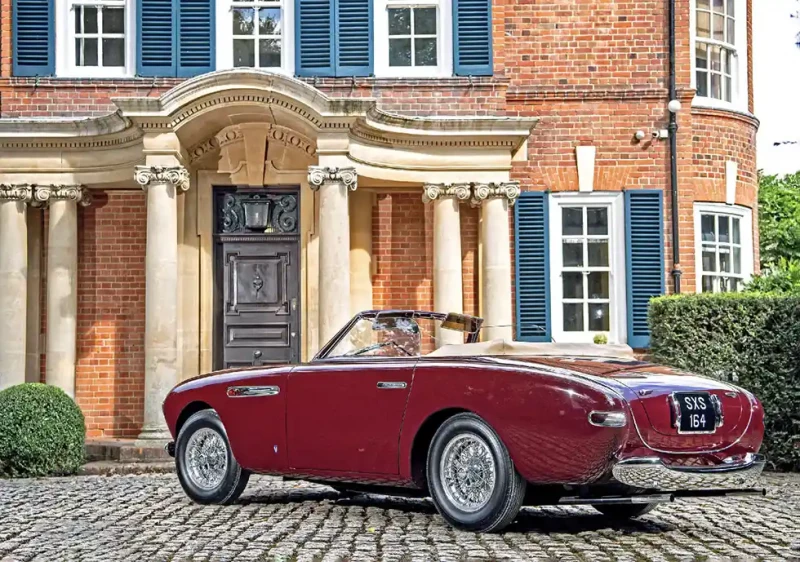
As a racing driver, Staechelin met Zurich restauranteur and racing driver Rudi Fischer on track at the 1949 Preis der Ostschweitz in the immediate pre-Formula One era, where Staechelin drove a BMW and Fischer a works Gordini. A year later, Fischer attempted to race his own self-built special, the SVA-Fiat, without success before taking on drives with Ecurie Helvetia Corse in its OSCA MT4, and a works HWM-Alta. Staechelin, however, had other ideas. Scion of a wealthy Basel business family, he formed Ecurie Espadon – Latinate form of swordfish, a speciality at Fischer’s restaurant – with the intention of creating a Swiss team that Fischer could lead on track. But which cars to base the team around?
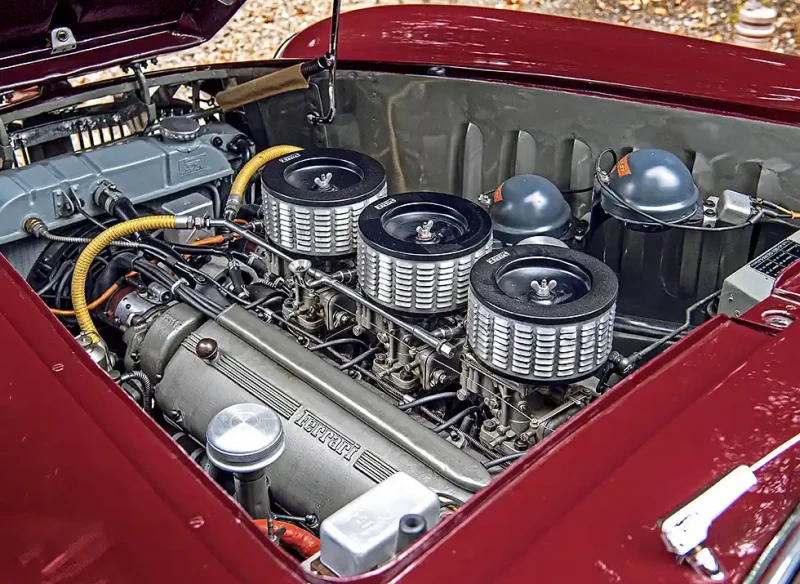
On 8 March 1951, Vignale pulled the covers off this Ferrari in Geneva. Ostensibly, this was a roadgoing version of the 166 replacement. The product of a three-year-old firm run by Alfa Romeo’s old competitions manager, which made successful and attractive sports cars. By the time this one left Geneva’s expo centre ten days later, Ferrari was a thoroughbred Formula One race winner, courtesy of Luigi Villoresi at Syracuse. By the time Staechelin arrived at dealer Giuseppe Santi in Rome in October 1951, Ferrari had won four more Grands Prix, the Carrera Panamericana, and its fourth consecutive Mille Miglia.
‘It may have the veneer of luxury, but it’s a barely-civilised racing machine’
If you wanted to win in 1951, buying a Ferrari was the obvious solution. In that trip to Rome, Staechelin bought three: the 1949-built chassis 12C single-seater, with a 125 supercharged V12 for F1 configuration and a 166 unit for F2; a 212 racer which could be rented out to pay-drivers – and this Vignale 212 Inter cabriolet showpiece as his own personal road car. In fealty to Enzo, the team was renamed Scuderia Espadon.
As I take in its form I’m imagining Staechelin’s first drive, perhaps contemplating fast Roman highways before breathless Alpine passes tested his new car to its limits en route to Basel.
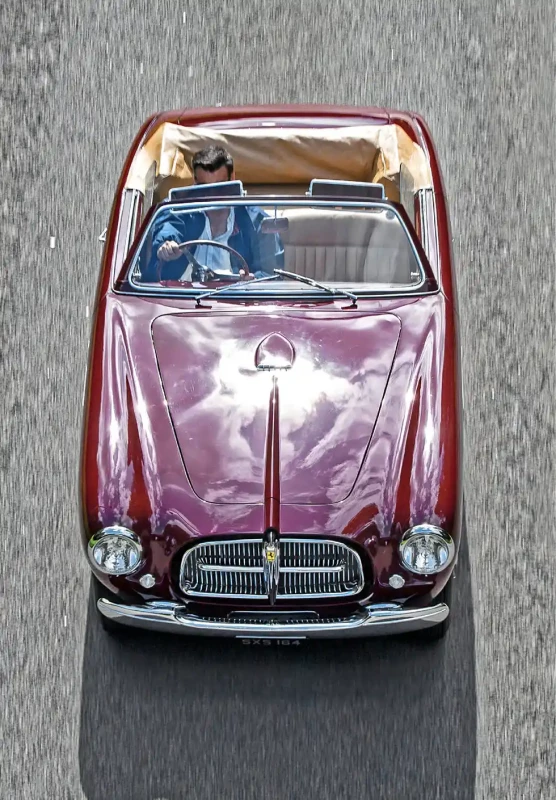
Fifties Ferrari styling can be somewhat heavy-handed, but Chrysler-style oversized grille chrome aside – which seems to solely serve as a plinth on which to display the Ferrari badge – Giovanni Michelotti’s work here is masterful in its sense of elegant understatement. Light units, so often messy off-the-shelf items on Fifties cars, even high-end ones like this, are deftly dealt with here. At the rear, the fluted chrome snugly cradles the brake lights. Side-repeaters are integrated into the Aston Martinlike chromed front wing vent devices.
I don’t know whether it’s a byproduct of the V12’s exhaust manifold shape, or whether the innards of the tailpipes are rifled, but at cold idle this car blows pairs of perfectly-formed smoke rings into the summer morning air. The chattering carburettors adjust, a larger gulp of air is taken, the revs rise ever so slightly, and another pair of ethereal circles appear, expand, and wheel away into the clear blue Hertfordshire sky. Under the bonnet might beat the same 12-cylinder heart of the cars that Piero Taruffi, Luigi Chinetti, Alberto Ascari and Luigi Villoresi tore to victory through the deserts of South America, but here it burbles like a playboy’s Riva motor launch on the end of a Sanremo jetty. The very definition of urbanity.
Fifties sports cars – even expensive ones – aren’t usually particularly ergonomic, but this cockpit is surprisingly spacious. The attention to detail is more reminiscent of some exquisitely-finished Thirties art-deco grand-tourer than a rough-and-ready Mille Miglia racer made civilised. Everything’s so finely judged, from the Roman numerals deeply etched into the Bakelite ball on the gear lever, to the chromed reverse-lockout button and the enormous Jaeger dials. There’s a proportionally perfect sense of placing to everything, for example the pull-handles beneath the Vignale-winged flashes in the door cards.
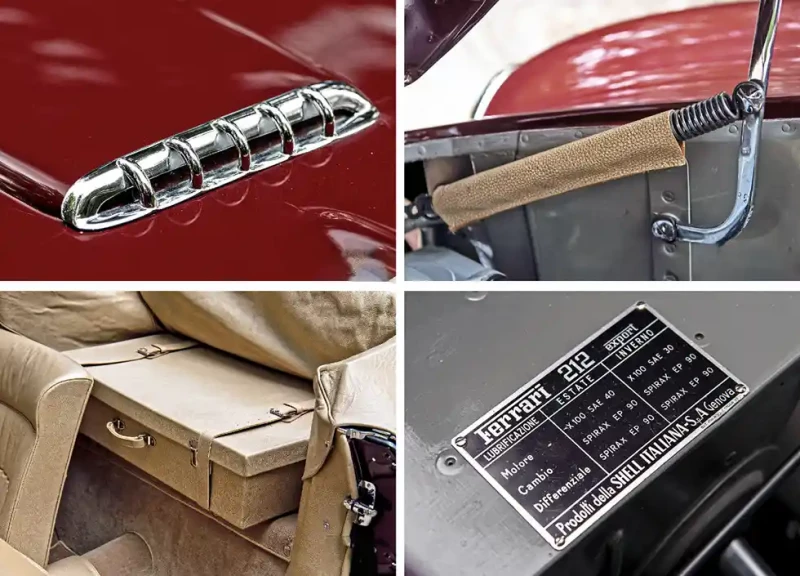
It’s taking in details like this that once again – as this car does so often – that forces me to think about the Ferrari marque in a different way. Enzo was under no illusion that success, no matter how hard-won, could be fleeting. This 212 also predated the Pinin Farina deal that shaped the 1953 250 Europa and gifted Ferrari an long-standing design language. With the price tags the road cars carried, Ferrari’s customers would in the main be mature, old enough to remember those art-deco grand tourers and the kinship they claimed with pre-F1 Grand Prix thoroughbreds. So, forget the generations of supercars this 212 sired for a moment; instead think of it as the upstart heir to cars like the Bugatti Atlantic and Talbot-Lago T150 CSS.
It wasn’t enough to merely clothe a roadgoing racer – the tailoring had to be good enough for Monaco’s Casino Square on the civilian side of the hay bales as well.
That Roman gear lever slots home remarkably smoothly for something without synchromesh on first. The 212 needs plenty of revs to pull away, but the V12 has so much silken torque that progress is smooth once you’re moving. There’s a metallic clank to the gear lever as I shift up and gain speed, but certainly up to 30mph the demeanour is friendly. Coupled with the surfeit of legroom, it could for a moment almost be considered languorous and even relaxing. Until I encounter a bend.
Even at speed, the steering is heavy, and the woodsandwiched metal rim with its joint-rapping studs feels brutal and unyielding. There’s a surprising amount of slack to take up before setting the car on its course, but this is a setup that demands you pick a line, keep to it, and push against a progressive but powerful self-centring action at the helm. It makes me wonder whether Ferrari drivers in the Mille Miglia’s production class encountered similarly uncooperative steering, and the consequences of that while attempting to negotiate unkempt mountain roads at speed.
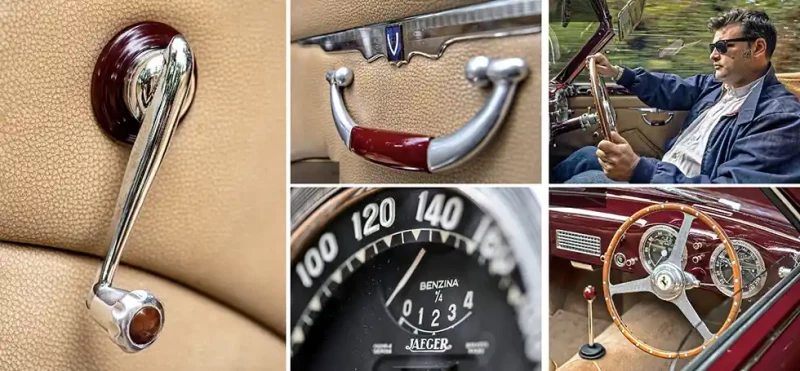
And yet, its sense of grand-touring comfort ultimately prevents driving the 212 from feeling like a chore, with only the narrowness of the gap between the accelerator and brake pedals giving any cause for ergonomic concern. The gearbox resists slipping into every ratio until you’re used to it, with downshifts requiring very precise rev-matching. Third into second is almost impossible to execute smoothly, even with careful double-declutching. Thankfully, the V12’s torque is such that the 212 will actually take a lot of low-speed corners in third, pulling away from as little as 1200rpm on the way out.
Truly tight bends reveal the limitations of Ferrari’s mentality towards chassis engineering though. His infamous adage that ‘chassis are for people who can’t build engines’ comes somewhat unstuck when the live rear axle bunny-hops sideways out of a roughly-tarmacked rural Chiltern hill bend and the bucking steering wheel assaults my fingers. A Jaguar of this era wouldn’t have done that, nor would an OSCA or even an Austin-Healey 100. In some ways, Ferrari still had a lot to learn, especially about handling and chassis engineering.
However, hammering down the A404, the tailpipes foghorning a solid Fifties-F1 mechanical growl over 3000rpm, it feels very much at home. I’m imagining Staechelin belting down the old Autostrada A8 out of Milan, the white-dusted Alps beyond, midday sun baking the open cabin and glinting the chrome; the Ferrari leaving little 50mph Fiat 500 Topolinos shuddering in its unrestricted three-figure wake. It feels like a template for a new kind of GT car. One which has all the tick-box trappings of the pre-war luxury era, but that when indulged turns absolutely every drive into a breakneck cross-country race. Its descendants nowadays have names like Stradale, RS and Competizione and flaunt lots of visible carbon-fibre, spoilers and roll cages. And yet, perhaps there’s virtue in the 212’s restrained modesty. How much cooler would such a modern supercar be if it didn’t feel the need to shout quite so loudly? Could a hardcore race-bred road car also be genuinely elegant?
Staechelin knew how hard-won racetrack success was. Scuderia Espadon’s drivers even included Hans Stuck, but he failed to finish at Ferrari’s home race at Monza in 1952, after Fischer had managed 11th and sixth in the 1951 Swiss and German Grands Prix respectively. Espadon’s most successful season was 1952, with Stuck finishing second in the Swiss Grand Prix and third in the German. Fischer went out on a high, securing Espadon’s only victory – the 1952 F2 Avus-Rennen – before announcing his retirement. Staechelin offloaded his racing cars to one-time Espadon driver and fellow Swiss Rudolf Schoeller for the following season. The Swiss Scuderia was no more. But Staechelin kept this Ferrari, returning it to Maranello for a triple-carburettor upgrade in 1953.
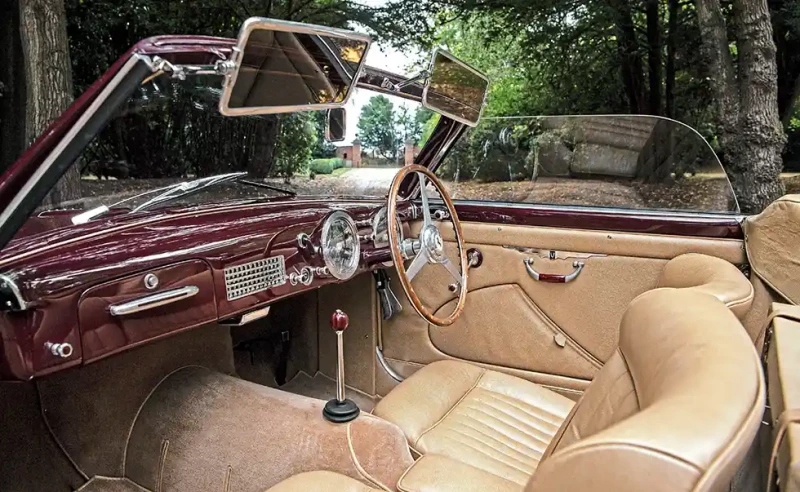
He remained a motor sport enthusiast, although one of the last events it’s known he drove this Ferrari to was the tragic 1955 Le Mans 24 Hours. Whether the disaster of that race, which saw 83 spectators killed, changed his mind about motor sport, is unknown. The Swiss government responded by banning motor sport in the country, and with it, cancelling Staechelin’s beloved Swiss Grand Prix forever. But the Staechelin family’s greatest passion – fine art – seems to have preoccupied Peter in the late Fifties. Keen to share his father Rudolf’s collection of Van Goghs, Cezannes, Matisses, Gaughins and Picassos with the nation, he was instrumental in the decision to place them on public display in the Kunstmuseum Basel. By 1959, a year before he sold the Ferrari, Staechelin had also become benefactor to the Swiss-Italian abstract artist Luigi Pericle. Pericle later described Staechelin’s ‘innate talent’, a skill of being able to ‘read the most complex of graphic lines; a virtuoso of seeing’.
As I park the 212 up and let it tick cool, I’m regarding it in another manner, that of art, and Staechelin as a connoisseur. Concept cars and short-run coachbuilt specials – this Vignale 212 Inter was the first of just four – are the true artworks of the automotive world, the hosting motor shows their exhibition halls. Staechelin might have regarded the works of a coachbuilder like Vignale perhaps in the manner of a contemporary modernist sculptor with an eye for organic forms, like Henry Moore or Barbara Hepworth, rather than a mere car body designer. Which raises the question – is this 212 Inter show car the first truly beautiful Ferrari?
Very early Ferraris tend to be spare, shaped-by-motorsport barchettas. Away from the racetrack, there’s a heavyhandedness and propensity for following fads about the early Ghia and Touring coupés, with an upright ponderousness more akin to Bristol or Aston Martin, or some of the late Forties designs visited on old Alfa Romeo 6C chassis.
But this 1951 Vignale design was different. It may predate the landmark Farina-designed 250 Europa by two years, but so much of what would make that design so important is here on Vignale’s earlier car. The smoothly-rolled trailing edge of the front wheelarches, for example. Or the gentle, uninterrupted curve of its barrel-sides. From side-on, its proportions seem beautifully judged too, avoiding the hunched, slab-sided look that so often came about from racing-derived Ferraris with too low a roof meeting high-sided bodywork beneath. By revelling in its role as a cabriolet – a pure road machine in which to tour, roof off when desired but up and doing a coupé’s job when necessary – rather than a hunkered hardtop or a pared-down roadster, this 212’s very essence is one of stylishness.
Staechelin’s greatest legacy is probably artistic, the establishment of the Rudolf Staechelin Foundation and its acquisition and loaning of great works of art to public galleries throughout the world. However, perhaps this Ferrari is part of that same artistic legacy. The creation of an automotive artist, Giovanni Michelotti. Viewed at an exhibition. Created perhaps as a kinetic sculpture representing the beauty and economy of movement of sport itself. And cherished by a man who knew first-hand how it felt to fall under motor racing’s spell, to appreciate sport as an art form of its own.
You’ll see it at concours d’elegance, but it would be just as much at home on a plinth in an art gallery.
Styling gun-for-hire Michelotti penned this 212 for Vignale. Chromework not overdone by ’50s standards This 212 took Staechelin all over Europe Nicely-trimmed sleeve stops spring rattling Shell partnering as old as the Ferrari marque.
Before Farina, Vignale bodied most Ferraris Surprisingly roomy for a Fifties Italian car 212’s steering feedback can border on violent. White-on-black Jaeger dials are pure racer. Elegance hides racing rawness in cockpit Styling was by then-Vignale man Michelotti. Detailing reminiscent of art-deco tourers.
‘Its descendants have names like Stradale, RS and Competizione’
TECHNICAL DATA 1951 Ferrari 212 Inter Cabriolet by Vignale
- Engine 2563cc V12, sohc per bank, three Weber 36DCF carburettors
- Max Power 170bhp @ 6500rpm
- Max Torque 152lb ft @ 5000rpm
- Transmission Five-speed manual, rear-wheel drive
- Steering Worm and sector
- Suspension Front: independent, unequal-length double-wishbones, transverse leaf spring, telescopic dampers. Rear: live axle, semi-elliptic leaf springs, telescopic dampers
- Brakes Drums front and rear
- Performance Top speed: 124mph
- Acceleration 0-60mph: 9.4sec
- Weight 1000kg
- Fuel consumption 18mpg
- Cost new £3200
- Value now £2m


